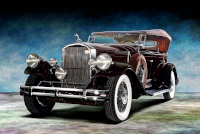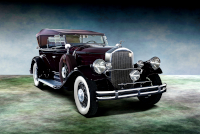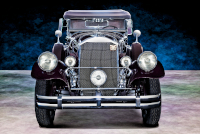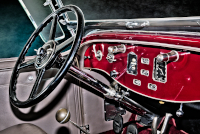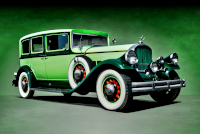Location:
RM Sotheby's, Hershey, 2023
Owner: Conrad Fletcher | Golden, Colorado
Prologue:
Approaching the RM auction for 2023, I'd spotted a few important Pierce-Arrow cars in the online catalogue and, with a soaking concours season just passed, anticipated the chance to see them with enthusiasm. Now finding this assortment lined up close together with some unfortunate glare left me a bit disappointed. But then I shouldn't doubt what I can do with a simple quarter perspective, even if the shot is foreshortened more than I would like.
The car is an important piece to me, a bit of catch-up dating back to 2007, when we first saw the sea green and goldenrod Model B Sport Phaeton known to the mid-Atlantic region. I can't commit to use my old photographs of that car, and never made good on subsequent opportunities to re-shoot. So this Model B is a valuable replacement. Fairly well known in its own right, #2025271 has traveled across the Atlantic twice, and across country a few times over as well. The old restoration still looks good, evoking a period piece aesthetic in understated colors that, on the whole, feels genuine to me. Neither overworked nor worn. As the first of the automobiles from RM 2023 I've profiled, I feel it has been worth the trip to serve up an important slice of the Pierce-Arrow pie.
- - - - - - - - - -
► Image Source: Nikon D750 (24.3 MP)
References:
- Ralston, Marc. "Pierce-Arrow" A.S. Barnes & Co., Inc., San Diego, CA. 1980, page 149-150, 158, 232
- Automobile Quarterly, Volume 6, Number 3, Third Quarter 1968, "Pierce-Arrow: An American Aristocrat" by Maurice D. Hendry, The Kutztown Publishing Company, Inc., Kutztown, PA, page 259
- Old Cars: "Car of the Week: 1930 Pierce-Arrow" by Al Rogers, August 15, 2023. A nice inside-out piece with contributions from prior owners, Terry and Rita Ernest of Port Huron, Michigan.
- RM Sotheby's: View the Hershey 2023 auction listing for chassis #2025271.
- Pierce-Arrow Society: Another crumb on the car's digital trail, the Emporium listed chassis #2025271 for sale in March of 2019.
- Hyman LTD: A very nice inside-out gallery of a comparable Sport Phaeton, this one in two-tone catbird blue.
The Model B Sport Phaeton is a slight update of 1929's Model 133 Sport Phaeton. The wheelbase is one inch longer, and the motor of equal power. The transmission adds some mechanical complexity to gain an extra gear for the first time in a decade. With the relatively modest scale of the car, a properly sorted gearbox paired with good brakes and reasonable steering effort creates a comfortable "smoother motion" that is "easier than some of the big cars from those days." Al Rogers quoted former owner Terry Ernest, and provides a more thorough driving impression in his article, so I will leave the balance of description to him. But we might suspect that the good-driving nature of a car such as the 1919 Model 31 lives on in the Sport Phaeton, albeit achieved by very different means using much simpler resources.
Al Rogers provides more history of #2025271, which most other sources parrot in some form: The Meyer family of St. Paul, Minnesota purchased the car new, and by 1938 exported the car to England and converted it to right-hand drive. After surviving World War II, an American serviceman bought the car and returned it to the United States in 1947, converting it back to left-hand drive. Whence found in California in 1970, restoration fell to Mr. Lee Garoyan, an economist who had served the Kennedy administration and consulted for the CIA, and who of course also restored classic automobiles.
Rogers writes, "Garoyan had to remove several non-factory items, such as vacuum brakes and a 1936 Buick trunk someone had integrated into the body using lead. A prior owner replaced the original Clark four-speed transmission with a Muncie three-speed." So Garoyan returned #2025271 to its original mechanical specification while enhancing the cosmetics. In this case, he sourced a set of correct chrome wire wheels—whereas this chassis originally wore the standard Hickory artillery wheels—and debated the livery with artist Ron Dreyer, who painted mock drawings of the car in different colors to gauge popular opinion. The results garnered top honors at national events across the country. Now a few decades on from Lee Garoyan's handiwork, our gallery reclaims a bit of the glamour that garnered so many national awards through the 1980s and 90s.
Folly of 1930, Pierce-Arrow Optimistic Despite Falling Behind the Trend
The story of 1930 is unrealistic optimism. Pierce-Arrow celebrated a highly successful manufacturing year, producing nearly 7,000 cars. But Ralston notes that, with their elation, "Pierce fell into its old pattern of producing too many variations—a poor decision in the face of a deepening Depression." Pierce-Arrow divided the model line among the A, B, and C, (A being the top-range), and distinguished each with its own wheelbase and motor displacement configurations. The difference is nominal, particularly where power output is concerned, and all use a modified version of the same basic 8-cylinder block. However, Ralston clarifies that while the 1930 Model C is a modified 1929 Model 133, both the Model B and Model A received up-rated motors with a new dual V-belt fan.
But not much distinguishes 1930 other than sales, which is rather poignant. The Al Rogers article on this Sport Phaeton references Pierce-Arrow's contemporary marketing slogan, a catty riposte to Cadillac's "Penalty of Leadership," which Pierce-Arrow embellished as, "The Tyranny of Tradition." I need to pick at this turn of phrase, because it so aptly summarizes the company's stagnation. Best would be, "The Cost of Conservatism," as in 1929 Pierce-Arrow have long proclaimed their complacence with the straight-6, begrudgingly accepted the 8-cylinder, and still stand two years from releasing the Karl Wise V-12. And yet their attitude is so vain, that Pierce-Arrow cannot change because their past accomplishments demand rigorous adherence to the status quo.
Meanwhile, Cadillac unveiled their V-16 in 1929, to go along with V-12 and V-8 models. So 'tyranny' is an ironic choice of words; conservative ideals are indeed becoming a tyrannical burden on the company, and using them as an excuse for not changing in the face of progress is a shame, not a justification.
Motor: 5997.7 cc (366 cubic inches) inline 8-cylinder, cast-iron block, #201664 | 88.9 mm x 120.65 mm (3½" x 4¾")
Valvetrain: L-head, 2 valves per cylinder
Aspiration: single Stromberg Model UU2 dual-updraft carburetor
Power: 125 hp @ 3,800 rpm
Drivetrain: Clark 4-speed manual transmission, rear-wheel drive
Once a mainstay of Pierce-Arrow technical superiority, the marque had not used a 4-speed gearbox since 1919. This Clark 4-speed unit only appeared for 1930 Model A and Model B cars.
Front Suspension: semi-elliptic leaf springs
Rear Suspension: live axle with three-quarter-elliptic leaf spings
Architecture: steel chassis, steel body panels on wood frame
Wheelbase: 3,403.6 (134 inches)
Etymology:
In 1930, Pierce-Arrow replace 1929's wheelbase nomenclature (the Model 133 and Model 143) with a simple alphabetical format. The new A, B, and C designations refer to three displacements. In this case, the Model A uses the largest, most powerful motor—next the Model B, and least the Model C, which "was in effect a modified 1929 standard 133 model," according to Ralston. So really, the Model A and Model B are the new models with new tooling for 1930. All Model A cars also use a longer 144-inch wheelbase, whereas the Model B uses either a 134 or 139-inch wheelbase depending on body style.
The 'Sport Phaeton' moniker is another matter, because the body style is effectively a dual-cowl phaeton. However, Ralston supports the nomenclature, which seems particular to the 134-inch wheelbase Model B. Perhaps the thinking is that a smaller, lighter platform deserves the term 'sport,' whereas the dual-cowl phaeton is typically a grandiose proposition. In any case, the 1930 Model B Sport Phaeton carries over from the 1929 Model 133 Sport Phaeton; both are very similar, save for technical and tooling upgrades and one nominal inch in the wheelbase. Such is Pierce-Arrow's penchant for tinkering with its models for the sake of creating differences of little distinction, which of course includes changing the model name.
Figures:
Pierce-Arrow built 53 Sport Phaetons in 1930, which is a body style specific to this 134-inch Model B chassis, carried over from the 133-inch wheelbase Model 133 of the previous year. This car, #2025271, is #53 of 53, the last one built.
Value:
Chassis #2025271 most recently sold at RM Sotheby's 2023 Hershey auction for $132,000. The original sales price was $3,300.
Sport Phaeton: Basic Design Features of the Pierce-Arrow Model B
Well this is a handsome design. The body binding runs to the hips at the tail, creating a discreet sweep panel up on the rear arch. The binding is broad and mostly flat, a nice belt below the gunnel. Atop the rear cowl, Pierce-Arrow use a gently curved windscreen rather than a linear copy of the front screen, which is a nice touch. As with most dual-cowl designs, the rear cowl tilts up for ingress and egress. Out back, the chopped tail and convertible hood create a high-top look that, in combination with the curt panel sweep, creates a junior Duesenberg effect. Inside, the instrument panel looks a bit like a simplified Cord L-29 design. In particular, the combination odometer-speedometer and Waltham clock are stylized tablets cut like book plates and edged in chrome, as likely seen inside the cover of an Aldous Huxley novel as inside an automobile.
Locomotive Look: Pierce-Arrow Carries the Big Grille into 1930
The radiator shroud has not changed much since the early days, whereas the chassis and coachwork has. Entering the classic era, these Pierce-Arrow cars achieve a locomotive-like front, accentuated by the separation of the headlamps. Chassis #2025271 goes one further by adding a single flood light to the directional bar. The effect carries over into the next year, particularly effective on the larger Model 42 and 41 cars. In relation, the 1930 Model B is a slight diminutive, particularly in short-chassis form.
Burgundy Livery: Lee Garoyan and Pierce-Arrow Paint Selection
The story about Lee Garoyan asking Ron Dreyer to paint mock-ups with different liveries is a clever (and oft-repeated) anecdote. Apparently they pinned up three different paintings and asked visitors to comment on their favorite, selecting the two-tone burgundy trim seen here without much controversy. Past liveries, if not original, used a mix of browns, greens, and mustard colors, which sounds more of the antique period. A more classy finish makes sense for a new look, as the chrome wire wheels are correct (offered as an option), though also not original to the car. The effect is very similar to a Model 133 Sport Phaeton that appears in Automobile Quarterly's Winter 1968 edition, a car that is actually a tri-tone red variation. Given the date of restoration in the 1980s, Misters Garoyan and Dreyer might have taken some inspiration from that image. I certainly made the connection when spotting the Model B in RM's roster, and checked the old reference to see whether this car were the same.
1930 Updates: Minor Additions for the 1930 Pierce-Arrow Model Year
On the bonnet sides, the new model year replaces a slatted panel (rather industrial in design) with a set of five Cadillac-type door vents. These vents are simple, but altogether more refined, and will stay with the series through 1933. The guards use a dual-bar configuration, common to most, though not all 1930 models. Ralston notes that the dual guard is a latter contrivance worked up to promote sales with added chrome, though its use seems almost ubiquitous.
Note that the badge on the grille screen is a 1987 commemorative for the Horseless Carriage Club of America 50th anniversary. The club serves pre-1916 automobiles, and the badge appears to have been added after the last purchase in 2019.
Last Updated: Mar 26, 2025

